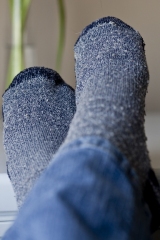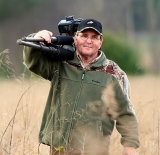- Forum
- Photography and Camera Forum
- Camera Manufacturers - by Brand
- Canon Camera Forum
- Making the jump to the L
Making the jump to the L
-
 Topic Author
Topic Author
- mj~shutterbugg
- The Lounger
-
- Canon 5d Mark iii; Canon 5D Mark ii; Canon 10D IR converted
- Followers: 46
- Posts: 1390
-
Points:
10
Post #210465
-

- d0wn
- New Kid On The Block
-
- Nikon D5000
- Followers: 4
- Posts: 39
-
Points:
0
-

- rmeyer7
- Master of the Lens
-
- Canon 6D, Canon 5D mk. ii, Canon 50D
- Followers: 105
- Posts: 1640
-
Points:
2086
Post #210625
I have only 1 L lens (24-105 f/4L), and the difference in sharpness makes me want to sink a whole lot of money into some more L lenses.
Just to offer my 2 cents:
My ideal set would include the 24-70 f/2.8, 70-200 f/2.8 and 135 f/2 (with that last one being absolutely the sharpest Canon lens I've ever seen). Those 3 would cover most of what I'd want to do so I'd recommend starting with some combination of them. Of course if you do macro or need a longer telephoto you'd want to change that list up a bit.
-

- Henry Peach
- Apprentice
-
- I currently use a 5DII or Sony Nex-3 most of the time.
- Followers: 50
- Posts: 2925
-
Points:
16
Post #210655
Bokeh is subjective. My L 24-70 f/2.8 has typical zoom lens bokeh. My Tamron 28-75 f/2.8's bokeh is smoother and creamier. It has none of the double edge bokeh the L exhibits.
I don't get the hype about sharpness. I haven't run into a lens that wasn't razor sharp (except damaged lenses) in decades.
-
 Topic Author
Topic Author
- mj~shutterbugg
- The Lounger
-
- Canon 5d Mark iii; Canon 5D Mark ii; Canon 10D IR converted
- Followers: 46
- Posts: 1390
-
Points:
10
Post #210700
Henry Peach wrote: I've spent plenty on money on L glass. They are lovely lenses, but I'll never buy another without renting it and comparing it to Sigma and Tamron's offerings. They aren't always better, but they almost always cost a lot more.
Bokeh is subjective. My L 24-70 f/2.8 has typical zoom lens bokeh. My Tamron 28-75 f/2.8's bokeh is smoother and creamier. It has none of the double edge bokeh the L exhibits.
I don't get the hype about sharpness. I haven't run into a lens that wasn't razor sharp (except damaged lenses) in decades.
Matt, would you say that in regards to ordinary Canon lenses as well? Most of my line up has been Canon with my 24 mm being a Sigma, but it is dying on me. I am really curious and value the feedback.
-

- KCook
- Photo Elder
-
- Canon EOS 50D and Olympus E-P5
- Followers: 1325
- Posts: 5410
-
Points:
32913
-

- Huberphoto
- Newbie
- Followers: 6
-
Points:
195
Post #211253
-

- Henry Peach
- Apprentice
-
- I currently use a 5DII or Sony Nex-3 most of the time.
- Followers: 50
- Posts: 2925
-
Points:
16
Post #211478
mj~shutterbugg wrote: Matt, would you say that in regards to ordinary Canon lenses as well? Most of my line up has been Canon with my 24 mm being a Sigma, but it is dying on me. I am really curious and value the feedback.
I use a variety of Canon, Tamron, and Sigma zoom and prime lenses on my Canon DSLRs. I need fast lenses so all my zooms are f/2.8, which for Canon brand means L. They all perform exactly as I expect modern lenses to perform. They each have strengths and weakness, but they are all quite capable of being used to create wonderful, sharp, finely detailed large prints. There is no way to tell which lens I was using from examining large prints or pixel peeping. Optical quality seems very similar to me among all of them. When a lens costs $500 and works great I love it. When a lens costs $1500, and isn't really any better than the $500 lens I'm somewhat disappointed. I own a number of >$1000 L lenses that I have complaints about. They are wonderful lenses, and if they cost less than $1000 I probably wouldn't gripe. But they are super duper, amazing and expensive L glass, yet seem typical to me, so I'm griping.
So what I'm saying is that I always hear sharpness mentioned as a reason to spend an arm and a leg on a lens, but that's not my experience. My experience is that all the prime lenses I've used from the last 1/2 century or so are very sharp, and any zoom lens I've used from the last decade or so is also very sharp. The reason to spend an extra $1000 is because the lens is waterproof, or has IS, or auto-focuses very fast and accurately, etc..., and these features would be advantageous to your shooting. If the lens isn't sharp enough it's damaged or a lemon. Or it's operator error. When I have sharpness issues I've learned that 99% of the time it's my fault.
My advice is that when investing big money on tools it's worth it to rent the tools and make sure it's the right tool for you. Or whether a significantly cheaper tool would work for you just as well. Then you could afford to buy several new lenses, and more lenses is more fun! Whooo hooo!!!!!
-

- Henry Peach
- Apprentice
-
- I currently use a 5DII or Sony Nex-3 most of the time.
- Followers: 50
- Posts: 2925
-
Points:
16
Post #211479
KCook wrote: My Canon 28-135 kit lens is less than razor sharp.
That focal length range is commonly complained about even among the high dollar offerings. That's why 28-75 or 24-70 is more popular. They squeeze just a bit more range into the design, but at a price.
-

- Henry Peach
- Apprentice
-
- I currently use a 5DII or Sony Nex-3 most of the time.
- Followers: 50
- Posts: 2925
-
Points:
16
Post #211480
Huberphoto wrote: ...they focus faster then third party lenses...
An excellent reason to choose one lens over another if fast AF is important. I've never had AF issues with the Tamron and Sigma normal range f/2.8 zooms I've used. They seem to work just as well as my Canon 24-70. In the 70-200 range there is no doubt that my Tamron's AF is a lot slower than my Canon L. But much of the time I'm manually focusing when using these lenses, so it's not a big deal to me. It would be a huge problem if fast AF was a requirement.
On the other hand since the Canon L 24-70 mk I has such awful field curvature I often choose to use my Tamron 28-75 f/2.8 (about 1/3rd price of the L) when doing group portraits. Hopefully they've fixed this in the mk II version, especially since they've really raised the price.
-
 Topic Author
Topic Author
- mj~shutterbugg
- The Lounger
-
- Canon 5d Mark iii; Canon 5D Mark ii; Canon 10D IR converted
- Followers: 46
- Posts: 1390
-
Points:
10
Post #212001
Henry Peach wrote:
mj~shutterbugg wrote: Matt, would you say that in regards to ordinary Canon lenses as well? Most of my line up has been Canon with my 24 mm being a Sigma, but it is dying on me. I am really curious and value the feedback.
I use a variety of Canon, Tamron, and Sigma zoom and prime lenses on my Canon DSLRs. I need fast lenses so all my zooms are f/2.8, which for Canon brand means L. They all perform exactly as I expect modern lenses to perform. They each have strengths and weakness, but they are all quite capable of being used to create wonderful, sharp, finely detailed large prints. There is no way to tell which lens I was using from examining large prints or pixel peeping. Optical quality seems very similar to me among all of them. When a lens costs $500 and works great I love it. When a lens costs $1500, and isn't really any better than the $500 lens I'm somewhat disappointed. I own a number of >$1000 L lenses that I have complaints about. They are wonderful lenses, and if they cost less than $1000 I probably wouldn't gripe. But they are super duper, amazing and expensive L glass, yet seem typical to me, so I'm griping.
So what I'm saying is that I always hear sharpness mentioned as a reason to spend an arm and a leg on a lens, but that's not my experience. My experience is that all the prime lenses I've used from the last 1/2 century or so are very sharp, and any zoom lens I've used from the last decade or so is also very sharp. The reason to spend an extra $1000 is because the lens is waterproof, or has IS, or auto-focuses very fast and accurately, etc..., and these features would be advantageous to your shooting. If the lens isn't sharp enough it's damaged or a lemon. Or it's operator error. When I have sharpness issues I've learned that 99% of the time it's my fault.
My advice is that when investing big money on tools it's worth it to rent the tools and make sure it's the right tool for you. Or whether a significantly cheaper tool would work for you just as well. Then you could afford to buy several new lenses, and more lenses is more fun! Whooo hooo!!!!!
Looks like I may be taking some tax return money and investing a bit. I think I will rent and see what works first and then if it's in budget, buy. Thanks for taking the time to give me your feedback.
-

- bhowdy
- The Lounger
-
- Canon 1d Mark IV
- Followers: 138
- Posts: 1277
-
Points:
52
Post #212067
Henry Peach wrote: I've spent plenty on money on L glass. They are lovely lenses, but I'll never buy another without renting it and comparing it to Sigma and Tamron's offerings. They aren't always better, but they almost always cost a lot more.
Bokeh is subjective. My L 24-70 f/2.8 has typical zoom lens bokeh. My Tamron 28-75 f/2.8's bokeh is smoother and creamier. It has none of the double edge bokeh the L exhibits.
I'm going to have to agree with Henry on this one particular example. I will put my Tamron 28-75 up against the Canon 24-70 all day long. What a great lens. It does make sense to rent lenses that you are considering purchasing and to compare them against one another.
I am a loyal Canon user and have several "L" series lenses. 100mm L macro, 135L, 17-40 f/4L, 70-200mm f/2.8L, 100-400, 300mm f/2.8L prime, 500mm f/4L prime, also have the Canon 50mm 1.4 which is not an L lens. But then I also have the above mentioned Tamron, also a Sigma 10-20mm F3.5 and the Sigma 120-300mm F2.8 OS
No lens manufacturer hits a home run with every lens in their offering line up. The same is true for the non OEM manufacturers. But some of the secondary manufacturers lenses are pretty darned good .... worth a look at them.
Bob Howdeshell
"If I could tell the story in words, I wouldn't need to lug around a camera" ~ Lewis Hine
- Forum
- Photography and Camera Forum
- Camera Manufacturers - by Brand
- Canon Camera Forum
- Making the jump to the L
Latest Reviews
The Fujifilm XT5 is a 40MP mirrorless camera capable of 6.2K video at 30p. With those specs, it’s an ideal choice for photographers needing a camera to pull double duty for imaging and video.
The Canon EOS R100 is an entry-level mirrorless camera introduced in 2023. But just because it’s an entry-level camera doesn’t mean it’s a bare-bones camera. Find out why in this review!
Nikon’s retro-looking Nikon Zfc is anything but retro. Under its classic body is a host of features and amenities that make it a worthwhile compact mirrorless camera for 2024.
The Canon EOS R50 is one of the newest R-system cameras from Canon. Is it worth your money? Find out all the details you need to know in this comprehensive review.
Latest Articles
Newborn photography requires skill, the right gear, and a lot of patience. This beginner’s guide discusses critical topics that will help you be more prepared for before, during, and after the shoot.
To fill the frame means to expand the footprint of the subject in your shot. Get in close, zoom in, crop the image, or use other techniques to bring the subject to the forefront.
With these simple yet effective beginner photography tips, you can avoid some of the common mistakes beginners make and get improved results with your images.
Urban photography is a genre showcasing features in urban settings. You can photograph people, architecture, mass transit, and many other subjects. Learn how to do so in this guide!
The Nikon D850 might be an older DSLR, but it was ahead of its time when it debuted in 2017. That means it still has plenty of firepower to compete with today’s powerful mirrorless cameras.
The best beginner camera isn’t the same for everyone. That means having choice is of the utmost importance. In this guide, explore five excellent beginner camera options for 2024 and beyond.
Child portrait photography is a unique undertaking requiring special skills and talents to get the best results. Start mastering this photography niche with these essential tips!
The Fujifilm XT5 is a 40MP mirrorless camera capable of 6.2K video at 30p. With those specs, it’s an ideal choice for photographers needing a camera to pull double duty for imaging and video.














